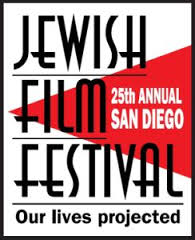By Laurie Baron

 SAN DIEGO─ This year marks the 25th anniversary of the San Diego Jewish Film Festival. To celebrate the occasion, the Festival will be screening four “anniversary classics” that were voted as favorites by its audiences: Aimee and Jaguar (1999), All My Loved Ones (1999), Gloomy Sunday (1999), and Nowhere in Africa (2001).
SAN DIEGO─ This year marks the 25th anniversary of the San Diego Jewish Film Festival. To celebrate the occasion, the Festival will be screening four “anniversary classics” that were voted as favorites by its audiences: Aimee and Jaguar (1999), All My Loved Ones (1999), Gloomy Sunday (1999), and Nowhere in Africa (2001).
As the author of a book on contemporary Holocaust cinema and the introducer of three of these four films, I must draw attention to the fact that all of them feature the Holocaust as central or as a backdrop to their stories. For many years I have heard people tell me that interest in the Holocaust in general, and movies about it in particular, is waning. They feel they seen too many motion pictures on the topic, and, that what they have watched is too emotionally upsetting.
Perhaps they misconstrue films focused on Jewish death and survival in the ghettos and death camps with the myriad of plotlines that have emerged out of the Holocaust. My response to what has been dubbed “Holocaust fatigue” is really a paraphrase of the epilogue to the old television series The Naked City: “There were nine million European Jewish stories [six million which ended in death, and, three million who survived] in the Shoah. Each film is about what one of them endured.”
For my book Projecting the Holocaust into the Present, I compiled a database on every feature film in which the Holocaust had been a primary or secondary topic and categorized them according to genres, themes, and the countries which produced them. It revealed a diverse corpus of works whose subjects, treatment, and relevance have changed over time and place.
These movies initially justified national responses to the genocidal assault of Germany against occupied countries with films from the Soviet Bloc generically reducing the murdered Jews to victims of fascism who were liberated by the USSR and Hollywood films stressing the role of the United States in hunting and trying Nazi war criminals, rehabilitating Displaced Persons, and helping them immigrate to Israel or America.
In the last twenty five years Holocaust films have proliferated as the event has become acknowledged as the greatest crime of the Twentieth Century. The collapse of the Soviet Union and the passage of time enabled filmmakers in countries that collaborated with the Germans or remained indifferent to the plight of the Jews to come to terms with that shameful legacy. Shifts in public attitudes towards gender orientation, multiculturalism, and women’s rights have carved out niches for Holocaust films which highlight these issues.
The four “anniversary classics” reflect how Holocaust films have evolved. Three of the four are German productions. Germany lags behind only the United States in the number of productions it devotes to recounting this bleak chapter in history.
Based on Erica Fischer’s dual biography of the same title, Aimee and Jaguar reminds audiences that Berlin still had a vibrant gay subculture even after Hitler’s assumption of power in 1933. A German woman in a conventional marriage to a Wehrmacht soldier stationed on the Eastern Front falls in love with a beautiful Jewish lesbian who conceals her identity to spy for England. Their relationship is doubly doomed as racially and sexually illicit.
The Czech production All My Loved Ones traces the vicissitudes of a Jewish family in Prague during the German occupation. It also pays tribute to Nicholas Winton who orchestrated the shepherding of endangered Jewish children to England.
Although Gloomy Sunday is the most fictionalized of the stories, it is grounded in the history of the era too. While its premise that the song Gloomy Sunday drove heartbroken people who heard it to commit suicide is an urban legend, it was so widely believed that the BBC banned playing it during World War Two fearing it would hurt morale on the home front. The enticing menage a trois consisting of a Jewish restaurant owner, a handsome pianist, and a beautiful waitress provides a narrative device for portraying the heartrending consequences of the imposition of Nazi racial laws on such relationships in 1944. The extortion of money from Jews by an opportunistic SS officer in return for their safe passage out of Hungary echoes the negotiations that spared the 1,600 Jews who evaded certain death by fleeing on the Kastner Train.
Finally, Nowhere in Africa garnered the Oscar for Best Foreign Film. Based on Stephanie Zweig’s autobiography, it introduces audiences to the handful of Jews who found a haven in Kenya only to have the British temporarily intern them as enemy aliens after the outbreak of World War Two. The coming of age story at the film’s center uniquely interweaves African and Jewish threads. Yet radio broadcasts repeatedly remind audiences of the far greater hardships remaining in Germany would have entailed.
If you haven’t seen these films, don’t be deterred by your stereotype of what constitutes a Holocaust film. If you have, you’ll probably be eager to view them again.
*
Baron is a professor emeritus of history at San Diego State University. Your comment may be posted in the space provided below or sent to lawrence.baron@sdjewishworld.com